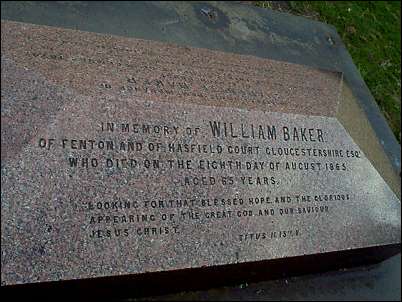![]()
![]() |
index: B |
|
index: B |
William Baker 1800-65
[ Web Site Index ]
| William Baker | People from Stoke-on-Trent | |
|
|
|
|
William Baker 1800-65 |
[ Web Site Index ] |
The family who built Fenton [also see William Meath Baker (his nephew)]
Key facts: William Baker's father (also named William Baker d.1833) was an architect from Audlem, Cheshire. He bought the estate and manor of Fenton Culvert together with a pottery factory - this was run by his second son (also named William)
William Baker did not marry but he had a brother named Revd. Ralph Bourne Baker who inherited all his estates his death in 1865.
When Ralph Bourne Baker died his son William Meath Baker (the nephew of William Baker) inherited the potworks & estates.
| 1800 | William Baker born - son of William Baker |
| 1839 | establishment of Fenton improvement commissioners |
| 1840 | WB became the first chief bailiff (appointed by improvement commissioners) |
| 1853 | He financed the building of Fenton Athenaeum on the corner of High Street East (now City Road) and Church Street (now Christchurch Street). |
| 1863 | In 1863 William Baker bought an estate called Hasfield Court, in Gloucestershire. |
| 1865 | WB died 8th August 1865 and left his estates to his brother the Revd. Ralph Bourne Baker. |

In memory of
William baker
of Fenton and Hasfiled Court, Gloucestershire Esq.
who died on the eighth day of August 1865
aged 65 years
Looking for that
blessed hope and the glorious
appearing of the great God and our saviour
Jesus Christ
1851 census:
Dwelling: 31 High Street (Fenton House)
| Name |
Marr | Age | Sex |
Birthplace | Occupation | |
| Mary Baker | M 81 F | Head | Shelton | Annuitant |
| William Baker | S 50 M | Son | Fenton | Joint coal proprietor. Earthenware manufacturer, employing 380 males 107 females Farmer of 31 acres employing 4 labs. |
| Jane Baker | S 40 F | Dau | Fenton | Lady |
| Charlotte Baker | S 35 F | Dau | Fenton | Lady |
| Thomas Naylor | S 30 M | Srvnt | Cheshire | Footman |
| Sarah Lowe | S 30 F | Srvnt | Shropshire | Cook |
| Mary Chatfield | S 38 F | Srvnt | Sandon, Staffs | Maid |
| Elizabeth Gee | S 26 F | Srvnt | Manchester, Lancs | Maid |
The potworks flourished under William Baker’s management and by the middle of the nineteenth century with almost 500 employees was the biggest firm in Fenton.
William Baker also described himself in the return as “Joint Coal Proprietor” because the partnership rented 18 acres of land on the south side of Fenton House which belonged to Lane End Chapel. Here they opened a colliery called Glebe Colliery which supplied coal to the factory and to other pottery manufacturers in the area. Next to the colliery they opened a brick-works served by an adjacent clay pit.
The colliery can be found on the Ordnance Survey map.
This colliery derives its name from its association
with the glebe lands of the parish church of St. Peter ad Vincula, Stoke.
The road alongside the location of this colliery is now called Glebedale Road
William Baker was also listed as a “Farmer of 31 acres” because he was cultivating the land in the vicinity of the colliery part of which he rented from John Bourne.
In 1863 William Baker bought an estate called Hasfield Court, in Gloucestershire.
William made plans to change it by refacing the brick walls with stone and adding a porch, but he died before the move was accomplished and the alterations were completed by his brother Ralph.William died on the 16th of August 1865 and the Staffordshire Advertiser reported that the day of his funeral was one of general mourning in Fenton. He was buried in Fenton Churchyard and the funeral was attended by many of the workers from his factory. His brother, the Rev Ralph Bourne Baker inherited the factory and the estates at Hasfield, Gloucestershire and Doveridge Woodhouse. He married the Bishop of Meath’s daughter, Francis Crofton Singer, and they lived at Hilderstone where he was the incumbent until 1860.
Here his son William Meath Baker was born in 1 November 1857. The family moved to Hasfield Court in 1865 where Ralph Baker died in 1875. The property was inherited by William Meath Baker. He did not take an active part in the running of the factories at Fenton, which traded as William Baker & Co., but he made regular visits to Fenton where like his uncle William IV he was heavily involved in the development of the town.
![]()